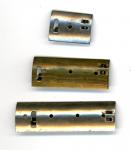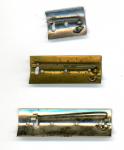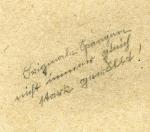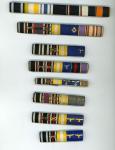-
Posts
194 -
Joined
-
Last visited
Content Type
Profiles
Forums
Blogs
Gallery
Events
Store
Everything posted by alan_g
-
3 Machine made brackets. Stamped shaped bracket. Top and bottom brackets are Iron brackets. The small bar (18mmx25mm) has a steel pin, suitable for one award 25mm. The 4 placer (18.5mm X 58mm) has an iron pin, suitable for 4 awards 15mm. The middle bracket is manufactured from stamped brass, with a brass pin. 18.5mm X 45mm, suitable for 3 awards 15mm. Although different materials, they all have exactly the same characteristics, with a minor variation as to the location of the hinge placements.
-
Bracket 5. 17.5mm hand manufactured. Iron bracket with sharp brass round pin. suitable for 1 30mm award ribbon or two 15mm award ribbons. The catch and the hinge have been stamped or shaped out of thin metal. The hook of the catch has been brazen onto a flat brass sheet before its addition to this bracket. The pin is the same brass as the hook.
-
Bracket 4. 17.5mm hand made from zink. Round brass pin with rounded point. Suitable for up to 10, 15mm award ribbons. On the front of the bracket is a pilot etch exactly in the centre of the bar. This is for guidance with the later placement of any devices, which would then be drilled into the bracket where the device would be added. The back hinge is a simple round piece of brass, which has been brazed onto the sheet metal. The brass pin has been fed through this hinge and curved under, to prevent falling out. The catch is quite crude, and looks like a modified uniform fastening catch.
-
Bracket 2. 17mm industrial stamped piece. Interesting catch production with a single strip of metal being used as the retainer for the round brass sharpened pin. The retainer is wrapped around the pin and then fed through the front of the bracket, and press folded into hollowed section. When the pin is released from its catch there is movement from the hinge, which would be expected from this type of manufacture.
-
Hi Guys, The process of looking at the pigments would be a better and easier step to take and I have asked some friends to help me out with this If I can pin a more accurate date for this piece then that would be great. I appreciate that this item has been done post war now. But still cannot understand why anyone would go to these HUGE lengths to create something so "unique" out of objects that hold no real significance if that makes sense? Who ever he/she was put a serious amount of effort into the research behind it. Obviously looking through old catalogues for brace manufacture numbers codes etc. As promised I will post on the Sutterlin from the back of this card. See if anyone can help work it out. I have a friend who I have asked to help translate this paragraph into better English from the German, to retain the detail and context of the script. I will also scan each individual brace front and back and post these to the thread as a further reference guide, as these are all comprised of different manufacturing assemblies. (Good opportunity for a collective focus at the "bare bones") I will post alongside these with the original breakdown of it's specifications.
-

Schlesischer Adler / Silesian Eagles
alan_g replied to dond's topic in Germany: Weimar Republic & Deutsche Freikorps
-
Here is an interesting ribbon bar dated to around 1939 to an officer with 12 years service. The order of the ribbons is wrong, with the KVK X being forced into 4th place by the three WWI decorations for the Iron Cross 2nd Class, Brunswick Military Service Cross and the Austrian military merit cross. The piece has been period repaired at some point with a silver service eagle (none matching) being pushed through the backing cloth. The original eagle would have been the silver version of more impressive type of eagle, as seen on here in gold. 1938 Hungarian commemorative medal with swords on the end. A nice piece!!
-

EK 1914 Sharing a ribbon with the Iron Cross ....
alan_g replied to Chris Boonzaier's topic in Germany: All Eras: The Iron Cross
Hi Chris, I think these medals shared the same ribbon, and were still being issued in your time frame: Haus Orden Von Hohenzollern Prussian Red Eagle Order. krieger verdienst medal 1888-1918 Prussian Crown order 1871-1918 Best Regards Alan. -
Hi Guys, I cannot work out why someone would go to the trouble of making this piece during the 1990's. I have taken onboard your points about changes in the German language which is useful. As words have changed since 1945. On the back of this item in pencil is something written in Sutterlin. I cannot read Sutterlin. So I make a scan of this and maybes this will shed some more light on this maybes. Failing that I wonder if the cardboard backing can be carbon dated? With it being an organic material this would maybes be all conclusive for a date. Then work out what exactly this was for, other than the reason I gave. If put in a museum of some kind this would have to be bigger for people to see, no? as the writing is very small. I cannot imagine there being a ribbon bar museum in Germany... if there is i'd be interested in a visit there Best Regards. Alan.
-

EK 1939 Ribbon Bar Wiederholungsspange
alan_g replied to alan_g's topic in Germany: All Eras: The Iron Cross
-
Such fast judgements passed without any kind of indepth explanation. The RZM was a Third Reich governing body. A collector in my opinion would have no need for such technical data. Collectors rarely want or collect blank undecorated ribbon bars, as there is nothing of interest to them. Nothing that can be admired or researched. This piece is more functional, which stands to reason why it would be used in a tailors shop, outfitters, or factory. It shows hand made and factory stamped varieties of acceptably approved ribbon bar brackets. They range on this card from 16mm - 20mm wide. Comprised of various metals. Iron, zink, steel and their components. They specify serienfertigung (series production) & handwerkerfertigung (artisan production). Obviously hand made pieces, like today, would have cost more to make possibly than the series production line standard pieces. This board comprises CHOICE for a punter. Like now, you don't get one variety of chocolate bar in a shop, you get hundreds of varieties all different prices. I assume the bracket choices displayed on this board would have had a price guide too. Translation: Title: comparative tabular original clasp plates and other industrial production in different clasp wide and various materials. The German font has rubbed off in parts I cannot work out some of the words, but I have done my best to write here what I see like for like: Die dicke der bleche war offiziell vorgeschrieben, wonach man sich aber nicht immer ichtet.. (cannot make out this word) hat. Es wurden z.B im Mitteilungsblatt der RZM vom 15.2. 1941 lediglich nummerierte blech ohne angabe genauer masse genannt. Fur die Grosse ordensdekoration die bleche Nr 3973, 10168 . Fur die kleine Ordenschnalle ohne orden (feldspange): Bleche Nr 4039, 12671, 12671, 12672, 9848, 10567 und 12013. Handwerklich fachgerecht hergestellte und andere zeitgenossische auch sehe einefach selbstgefertigte spangen gelten in jedem fall als originale. Die perforationen in den blechen fur die bar devices wurden in diesen fallenfast immer nur nach bedarf zur jeweiligen auszeichnung gebohrt, teilweise grob eingeschlagen. Aufgeloetet halteoesen fur die nadeln sowie scharniere existieren hierbelen verschiede arten. Rueckseitig wurden die bander meist vernaht aber oft nur verklebt wie es auch an aufstucke den fall ist die vernahten bander an den gewoelbter spangen wurden meist mit einem filzstreifen abgedeckt und ibohmals vernaht. Es wurden 15 bis 18mm breite ordensband sewie litze lederstreifen finnen seidenstreifen baumwolle, leinen und Samtstreifen bis hin zu gemusterten textilien etc benutz. gelegentlich wurden auch diese streifen aufgeklebt. English translation through google. The thick of the sheet metals was officially prescribed, according to which one did not however always ichtet (cannot make out this word) oneself. Were called e.g. in the news sheet of the RZM from the 15.2. 1941 only numbered sheet metal without information of exact mass. Fur the large one medal decoration the sheet metals NR 3973, 10168. Fur the small medal buckle without medal (field clip): Sheet metals NR 4039, 12671, 12671, 12672, 9848, 10567 and 12013. For the small medal buckle without medal (field clip): Sheet metals NR 4039, 12671, 12671, 12672, 9848, 10567 and 12013. By hand professionally manufactured and other zeitgenossische also see manufactured clips being valid onefold in jedem case than original.nnThe perforations in the sheet metals for without DEVICEs were bored into these fall nearly only as required for respective honor, hit partly roughly. Eyelets soldered needles for the hinges and there are different types hierbe...n (cannot make out this word) REAR the bander usually sutured but were often glued as it is the case of the aufstucke vernahten bander at the most vaulted slides were covered with a feltstripes ibohmals(cannot make our word properly) and sutured. There were 15 to 18mm wide decoration ribbon sewie Braid leather stripe stripes finns are cotton, linen and velvet stripes to patterned textiles etc never use. sometimes these were glued strips.
-

EK 1939 Ribbon Bar Wiederholungsspange
alan_g replied to alan_g's topic in Germany: All Eras: The Iron Cross
Hope these examples have been useful to your own research Peter like Pokemon you have to collect them all!! -

Austria Austrian German Ribbon Bar
alan_g replied to alan_g's topic in Central & Eastern European States
-
I don't think that the last ribbon is a life saving ribbon, if it was a German award, surely it would have come before the Turkish order Christer could possibly onto the right track with the Swedish Vasa order. None of the ribbons are "blinged" up to tell us more... No crowns or wreaths... good one to decipher though
-

EK 1939 Ribbon Bar Wiederholungsspange
alan_g replied to alan_g's topic in Germany: All Eras: The Iron Cross
-

EK 1939 Ribbon Bar Wiederholungsspange
alan_g replied to alan_g's topic in Germany: All Eras: The Iron Cross
Erhard Milch would also be upset that you think this spange was a fake... As he wore it on his ribbon bar...


























